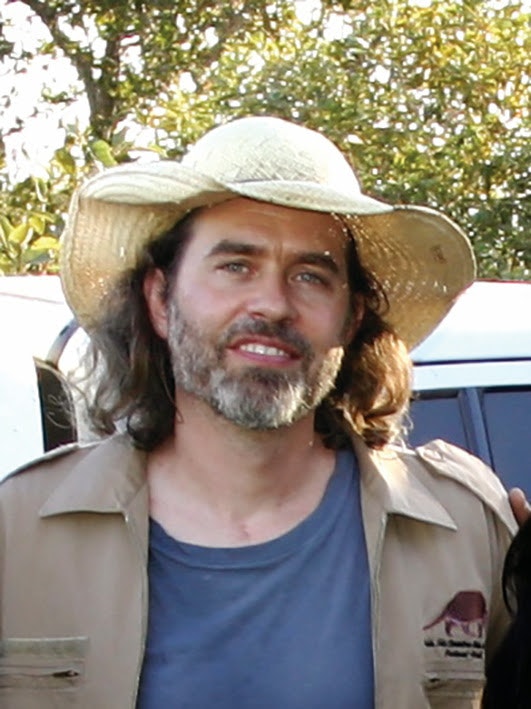Winner of the Whitley Award donated by the Garden House School Parents’ Association
A conservation ambassador
In 2010 Arnaud Desbiez set up the Giant Armadillo Conservation Project in Brazil’s Pantanal – the largest wetland in the world. This was the first long-term study of giant armadillos. At the time, little was known about this enigmatic species and few landowners even knew of its existence.

Ecosystem engineers
Initial research uncovered some surprising results. Radio-tracking giant armadillos has enabled Arnaud to map habitat use, whilst camera traps have revealed crucial information about parental care, and show armadillo burrows providing refuge for over 25 species, demonstrating their role as an ‘ecosystem engineer’. A national outreach campaign was launched reaching 65,000 people directly, and the giant armadillo was subsequently selected by State authorities as an indicator species for the creation of protected areas in the State of Mato Grosso do Sul.

Susceptible to extinction
The project is now expanding to the Cerrado, a tropical scrubland that has disappeared by more than 50% in the last 35 years. Compared to the pristine Pantanal, in the Cerrado the giant armadillo faces the threat of habitat loss, agricultural pesticides, fire, hunting and busy roads. The issues are more pressing considering the naturally low densities at which giant armadillos occur, making them more susceptible to local extinction.

Arnaud’s project will:
- Collect data to support the creation of a network of protected areas and tackle threats to the species’ survival in partnership with local stakeholders.
- Promote giant armadillos as a conservation flagship by conducting educational outreach among landowners, school children, and the public.
- Build capacity to conserve this rare species by providing Brazilian biologists and vets with hands-on training.
Why it matters:
- Only 2.2% of the Cerrado is under legal protection.
- Armadillos are one of the oldest groups of mammals and giant armadillos are often considered a living fossil.
- The provision of hands-on experience in conservation is vital for the growth of the profession in Brazil.
“More and more people are now aware of the species’ existence and the important role they play as ecosystem engineers.”
PROJECT UPDATE
2019 CONTINUATION FUNDING
Preventing Giant Armadillo Extinctions
Brazil
£68,000 over 2 years
The Giant Armadillo is a rare, South American species classified as Vulnerable to extinction; however, increasing human-wildlife conflict is threatening their existence in Brazil. They were found in two sites in the Atlantic Forest biome 10 years ago but recent studies have sadly indicated their functional extinction in one of these sites. There are already emerging threats in Rio Doce where they remain, with increases in poaching, frequency of fires due to climate change and habitat fragmentation. Arnaud’s project aims to prevent their extinction in what is potentially their last remaining habitat in the Atlantic Forest by conducting research on their population status, improving habitat management and implementing education and awareness raising programmes in Rio Doce State Park to build pride in this critical population.
Adopting a multi-site approach, Arnaud will also work in the Cerrado biome, where local extinctions have been documented due to conflict with beekeepers who kill armadillos in retaliation when precious hives are raided. Arnaud and his team will look to eradicate the conflict by seeking solutions to protect farmers’ beehives and establish a honey certification scheme to create benefits from the presence of giant armadillos and incentivise the conservation of this amazing species.
PROJECT UPDATE
2023 Continuation Funding
Protecting and connecting Giant Armadillo habitat
£100,000 over 2 years
The Cerrado of Mato Grosso do Sul in the Brazilian Pantanal is home to the giant armadillo, an elusive species deemed Vulnerable on the IUCN Red List of Threatened Species. Only 69 viable fragments of suitable giant armadillo habitat remain in the region, surrounded by a matrix of private and agricultural land.
The species’ survival now depends upon restoring connectivity between these fragments, to allow the animals to disperse and reproduce effectively.
Arnaud Desbiez’s Continuation Funding grant focusses on protecting an area of land which has the highest chance of maintaining a healthy population of giant armadillos: a neglected municipal park. Building directly upon WFN-supported research that mapped the distribution of the giant armadillos in the Cerrado of Mato Grosso do Sul state, this new project will see collaboration between local stakeholders including landowners, schools, and football match attendees, to protect this patch of land.
Although the project is focussed on giant armadillos, linking together their habitat will be beneficial to local biodiversity, positively impacting many other species. Using extensive camera trap data, Arnaud and his team will evaluate the diversity of medium to large size vertebrates within the park – where they are currently working to prevent the construction of a paved road.
Arnaud and his team at Instituto de Conservação de Animais Silvestres have also worked closely with local beekeepers in the region to stop retaliation killings of the giant armadillos (who can be prone to stealing honey), supporting co-existence through a honey certification programme that’s seen 130 beekeepers recognised as producers of armadillo-friendly honey. With support from Continuation Funding, the certification project is set to expand beyond Mato Grosso do Sul to the rest of Brazil, helping the species to live in these habitat pockets without persecution.



